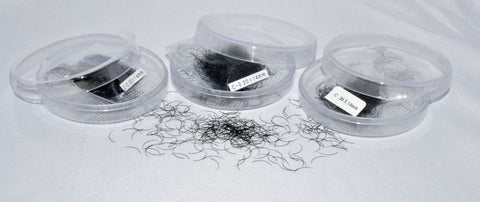Je winkelwagen is leeg
Online Groothandel voor Beauty Professionals - Beauty Opleidingen - Schoonheidsinstituut
As we are reaching the end of the decade, I found myself reflecting on the last 10 years and how far I’ve come. I no longer bleach my hair with the lightest shade of bleach from the drugstore and I have swapped weekly 5 min sunbeds to daily SPF50 sunscreen. I’m no longer getting my lashes done for €19.00 and they are no longer the 0.25 thick, droopy cat-eye look with 8-12 mm. I now pay around €125.00 for a full set; but have soft, fluffy and light lashes that complement my face and last 4 weeks before I need an infill. Looking back at the eyelash extensions industry, we have really come a long way. That makes me wonder, where will we be in 2030?
At the beginning of the decade, loose lashes were the norm. For the new generation of lash artists, loose lashes were the same extensions that you use today but in a little pot or a mini grip bag. Loose lashes were everywhere!
Although I trained with lashes on the strip, in 2012 I worked in a reputable salon in London where I struggled with the leathery mat and X-shaped tweezers (does anyone remember those? WHY?!) I spent my days doing wrist acrobatics, trying hard to pick up a loose lash in the correct direction AND do an infill in 30 minutes! I later heard that loose lashes became so ingrained in the daily life of a lash artist that when the lashes on a strip started becoming available on the market, there were artists that would peel the lashes off the strip, place them on the mat, and work with… well, loose lashes!
When I worked from home, I still decided to work with strips but I had no such thing as a lash palette. I had a box for lashes and that served me as a lash palette. Comfortable? No. Hygienic? Hell no! But definitely better than loose lashes.
I also tried sticking lashes on the back of my left hand until London Lash Pro introduced ceramic palettes to me. What a revelation! Today I have a beautiful box with palettes in it, each palette has extensions in different thicknesses, mixes of curls and colours. Beautiful, organized and dust-free.
One of the most important changes in the industry for me was the introduction of proper pre-treatment and cleaning of the lashes. I first tried a pre-treatment around 2014, it stank of alcohol (one of my clients even asked my why she could smell vodka!) and burnt like hell if it went in the eye. But hey - that was the first time I really noticed a huge difference in retention. Today we have a wide variety of pre-treatment products - my favorites are the Melon scented cleanser and the Booster - bad retention is a problem that is totally solvable!


Then the industry got turned upside down. We had been teaching the golden rule that you can ONLY put one extension on one natural lash. One by one. And then Russian Volume arrived and claimed that you can safely apply 3-6 extensions per one natural lash. To be honest, at first, I really didn’t like the way they looked. I found them too thick, crazy and fake. But Hanna Putjato taught me that volume doesn’t have to be dramatic - it can also be extremely soft and light, in fact, the three extensions placed on one natural lash were actually lighter than my 0.20 lashes. WOWZA.

Volume lashes were probably a breaking point in the industry. We started focusing on the safe application, working with layers to achieve the perfect top line, we started working with different stylings. We began running competitions and started seeing absolute masters in the industry spend 3-5 hours on their creations and in terms of business, the lash industry started blossoming.
5-10 years ago, most lashes I saw on the London Underground were really, REALLY bad. Stuck together, too long, too heavy, too straight… Today I see more and more beautifully crafted sets wherever I go.
With retention, safety and techniques finally nailed, I predict that the lash industry will move forward towards client-focused services. Time is money and I think that the speed of the treatment will be one of the key things that will change. Allergies might be another thing to tackle - how many clients have we turned away because they have developed an allergic reaction to cyanoacrylate? Please lash gods and scientists, send us some ideas on how to solve this!
What do you think has been the biggest change in the industry? And where do you think the industry will be at the end of 2030? Which trends that we have now will become a joke in the next decade? Let me know in the comments below!
Merilin Notton,
Brand Director & Co-Founder of London Lash
